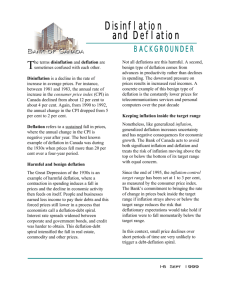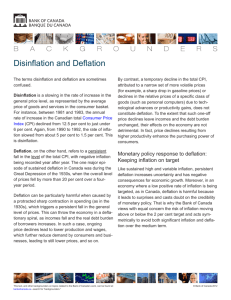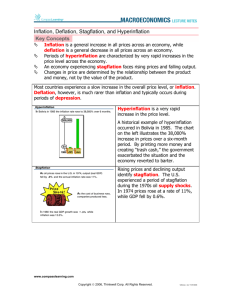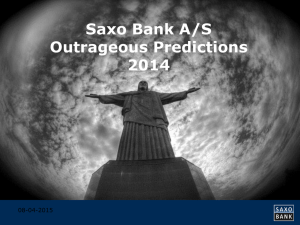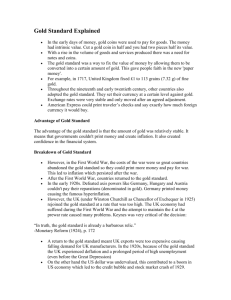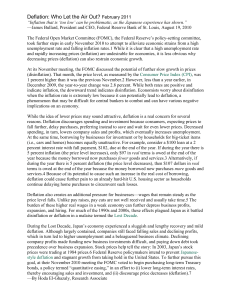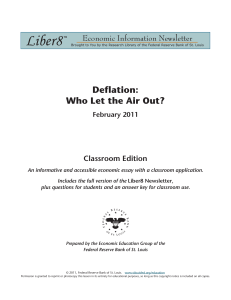Deflation or disinflation?
advertisement
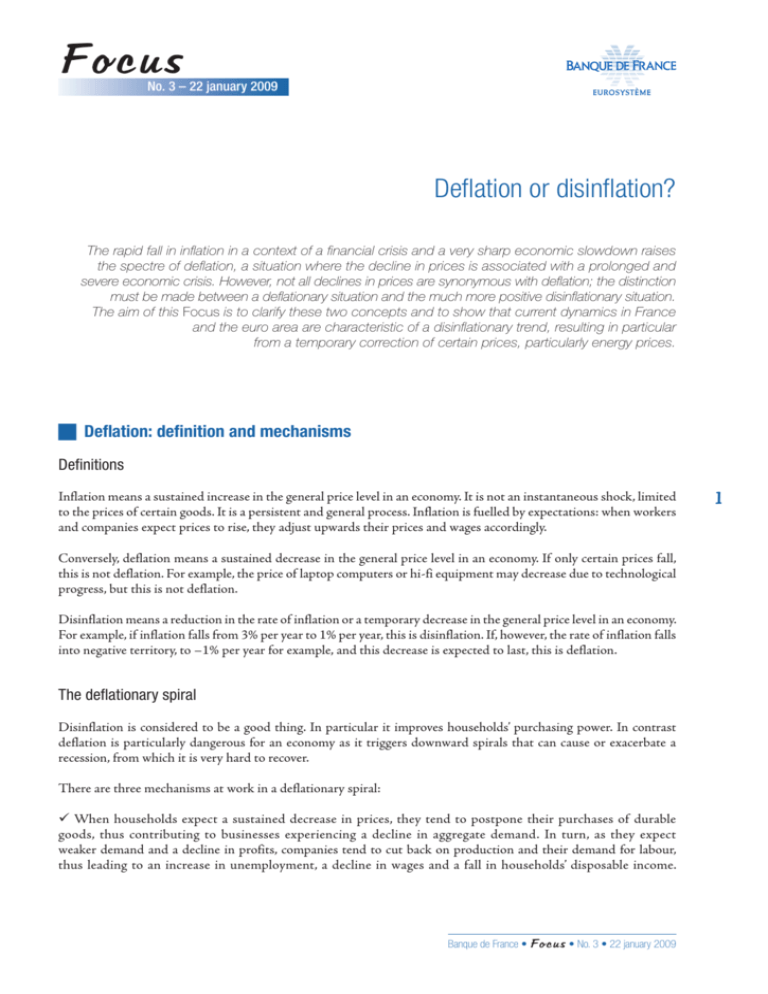
Focus No. 3 – 22 january 2009 Deflation or disinflation? The rapid fall in inflation in a context of a financial crisis and a very sharp economic slowdown raises the spectre of deflation, a situation where the decline in prices is associated with a prolonged and severe economic crisis. However, not all declines in prices are synonymous with deflation; the distinction must be made between a deflationary situation and the much more positive disinflationary situation. The aim of this Focus is to clarify these two concepts and to show that current dynamics in France and the euro area are characteristic of a disinflationary trend, resulting in particular from a temporary correction of certain prices, particularly energy prices. J Deflation: definition and mechanisms Definitions Inflation means a sustained increase in the general price level in an economy. It is not an instantaneous shock, limited to the prices of certain goods. It is a persistent and general process. Inflation is fuelled by expectations: when workers and companies expect prices to rise, they adjust upwards their prices and wages accordingly. Conversely, deflation means a sustained decrease in the general price level in an economy. If only certain prices fall, this is not deflation. For example, the price of laptop computers or hi-fi equipment may decrease due to technological progress, but this is not deflation. Disinflation means a reduction in the rate of inflation or a temporary decrease in the general price level in an economy. For example, if inflation falls from 3% per year to 1% per year, this is disinflation. If, however, the rate of inflation falls into negative territory, to –1% per year for example, and this decrease is expected to last, this is deflation. The deflationary spiral Disinflation is considered to be a good thing. In particular it improves households’ purchasing power. In contrast deflation is particularly dangerous for an economy as it triggers downward spirals that can cause or exacerbate a recession, from which it is very hard to recover. There are three mechanisms at work in a deflationary spiral: 9 When households expect a sustained decrease in prices, they tend to postpone their purchases of durable goods, thus contributing to businesses experiencing a decline in aggregate demand. In turn, as they expect weaker demand and a decline in profits, companies tend to cut back on production and their demand for labour, thus leading to an increase in unemployment, a decline in wages and a fall in households’ disposable income. Banque de France • Focus • No. 3 • 22 january 2009 1 Deflation or disinflation? 9 Following the crash of 1929, a second process was identified by the US economist Irving Fisher, who in 1933 put forward his “debt-deflation” theory. Deflation automatically increases the real cost of debt, which is generally not indexed to price developments. This rise in the cost of debt worsens the position of borrowers, notably companies, which can lead them to curb their investments, or even to go bankrupt. Likewise, the rise in household debt can lead to an increase in savings, which accelerates, by a self-sustaining mechanism, the decline in aggregate demand. Lastly, the bleaker outlook for companies prompts banks to tighten their credit standards. Deflation is thus combined with a credit crunch, i.e. a sudden reduction in the availability of bank credit. 9 Lastly and most importantly, deflation can paralyse monetary policy. It is impossible, of course, to reduce interest rates below zero. However, even with interest rates at zero, if prices are falling, for example by 2% per year, real interest rates in the economy are in fact strongly positive (in this case at 2%) even though the situation (a sharp slowdown in growth or a recession) would, on the contrary, call for negative real interest rates. Deflation thus imposes very high real interest rates on the economy compared with what is necessary. It therefore contributes to creating and sustaining a recessionary spiral from which it is very difficult to recover: the more growth slows down, the more prices fall and the higher real interest rates are, which further exacerbates the slowdown in growth. J France and the euro area are in a disinflationary situation When this Focus was written, the situation was as follows: 9 Euro area countries have recorded a decline in the general price level since the autumn of 2008 and a rapid slowdown in the annual rate of inflation: from 4.0% in July in France and the euro area to 1.2% and 1.6% respectively in December 2008 (see Chart 1). This slowdown is occurring much faster than forecast just two months ago. It has, in itself, a stabilising effect on the economy, since it triggers an increase in real income. Chart 1 – Changes in the harmonised index of consumer prices 9 Two factors have contributed to these developments: 2.5 • first, the drop in oil and commodity prices: these prices rose by more than 50% in euro terms between July 2007 and July 2008 (and by over 75% in dollar terms); they have returned to their previous levels and it is unlikely that they will start rising very rapidly again; (as a %) 4.5 4.0 3.5 3.0 2.0 1.5 1.0 0.5 Dec. Q1 2005 Q2 Q3 2006 Germany Q4 Q1 Q2 Q3 2007 France Q4 Q1 Q2 Q3 2008 Q4 Euro area Source: Eurostat; calculations: Banque de France. • second, the downturn in economic activity, which has been much more pronounced and much faster than expected; in its June business survey, INSEE forecast growth in the French economy in 2008 of 1.6%, whereas in fact it is estimated to be close to 0.7%. It is likely that the United States and several euro area countries will see negative inflation – i.e. a year-on-year decline in the general price level – for some months around mid-2009. This situation is expected to be temporary. It is linked to «base effects» as a result of which, starting from very high levels, the fall in oil prices gives the appearance, in year-on-year terms, of a decline in the general price level. Banque de France • Focus • No. 3 • 22 january 2009 2 Deflation or disinflation? The emergence of a deflationary spiral currently appears unlikely Several months of negative inflation are not enough to produce deflation. For deflation to occur, a continuous and self-sustaining process of a decline in the general price level needs to arise. There are currently several powerful brakes on and obstacles to the emergence of such a process: 9 Price and wage dynamics remain very positive. Prices excluding energy and food products are little affected by changes in energy and food prices. This was true when prices were rising (see Chart 2) and it should remain true as they fall. Chart 2 – Prices excluding energy and food in France (as a %) 2.8 2.6 2.4 2.2 2.2 Wage dynamics are also largely autonomous given that, in the euro area as a whole, the proportion of automatic indexation mechanisms is relatively small. This «rigidity» in nominal wages can prove damaging if the competitiveness of the economy is jeopardised. In periods of disinflation, it acts as a powerful stabiliser countering the risk of deflation. In France, wages, which rose significantly in 2008 (by 2.7%), and which are crucial in determining the price developments of many products and particularly those of services, are expected to grow less strongly, but nonetheless at a rate above 2%. 2.0 1.8 1.6 1.6 1.4 1.2 1.0 Dec. Q1 2005 Q2 Q3 2006 Q4 Q1 Q2 Q3 2007 Q4 Q1 Q2 Q3 2008 Q4 HICP excluding energy and food Of which services HICP Source: Eurostat; calculations: Banque de France. 9 The measures taken to support the economy and the financial sector reduce the likelihood and potential magnitude of a negative price shock. Growth in all countries is currently being severely undermined by a crisis of confidence and disruptions to the financial system. But very substantial measures have been taken very quickly by central banks and governments to stabilise the financial system and stimulate demand (public investment and household consumption). This is a major difference compared with previous banking crises: the response of the public authorities has been rapid and on a large scale, which has considerably reduced the risk of uncontrollable systemic contagion. 9 Lastly and most importantly, inflation expectations remain strongly positive. We should recall that deflation is not possible while households and enterprises continue to expect price rises. This is incontrovertibly the case at the moment. Business surveys, measures derived from market rates and forecasting experts surveyed by the ECB all point to five-year inflation expectations remaining anchored around 2% for the euro area as a whole (see Charts 3 and 4). From this point of view, the Eurosystem’s monetary policy framework provides substantial protection. Unlike other central banks, the ECB has set out a quantified definition of its price stability objective: an annual increase in the general price level “below, but close to, 2%”. This definition, which economic agents know guides monetary policy, greatly contributes to anchoring expectations. Banque de France • Focus • No. 3 • 22 january 2009 3 Deflation or disinflation? Chart 3 – Enterprises’ expectations of sales prices Chart 4 – Euro area markets’ inflation expectations (year-on-year % change) (as a %) (balance of opinions as a %) 25 20 15 10 5 0 -5 -10 -15 -20 -25 -30 5 4 3 2 1 0 -1 -2 -3 -4 -5 -6 1996 1997 1998 1999 2000 2001 2002 2003 2004 2005 2006 2007 2008 Producer price index (left-hand scale) Outlook for prices (right-hand scale) Source: INSEE. 3.5 3.0 2.5 2.0 1.5 1.0 0.5 0.0 Q1 Q2 Q3 Q4 January 2008 2009 Average 5-year. 5-year forward inflation rate derived from ILS swaps 5-year inflation swap rates Sources: Bloomberg, Datastream. Once the shock of the fall in energy and food prices –which may lead to temporarily negative inflation rates in mid-2009– has been absorbed, the year-on-year change in prices should become positive again in the autumn, at which time the base effects with respect to energy prices will have disappeared and the measures taken by central banks and governments to stabilise the financial system and stimulate the economy will have fully borne their fruit. According to current projections, inflation is expected to increase again in the third quarter and to reach an annual rate of over 1.5% at the end of 2009. Projections for 2010 for France and the euro area currently stand at 1.4% and 1.8% respectively –in other words, at levels that are very close to the Eurosystem’s definition of price stability (“below, but close to, 2%”). Contact : robert.ophele@banque-france.fr Banque de France • Focus • No. 3 • 22 january 2009 4
